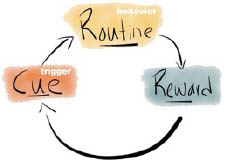Many of us tend to use this time of the year to make well-meant promises to ourselves to become healthier and happier. Unfortunately, new year resolutions notoriously start to disappear by the time February rolls in. Sometimes we barely even notice ourselves slip back into our usual routines. How do we implement these promises into our daily schedule so that they stick and become new habits?
We spend about 50-70% of our waking time performing habitual behaviors. Our habits construct our lives. They have a distinct structure and pattern. In this article we will discuss the elements of habits, and share tips to help manage them.
Breaking Down Habits

According to Charles Duhigg in his book, Power of Habit, the basic structure of all habits includes:
Cue – The trigger that signals the activation of the habit. Usually a time, place or an event.
Routine – The behavior, or the acting out of the habit.
Reward – The feel good/neuro-release that fuels the habit (signals the brain that it is a worthy action).
Let’s use a couple of examples for the purpose of context.
#1
Habit/Routine – Eating late night snacks.
Cue – A specific time every night.
Reward – Satiety or, ‘fix’ for a sugar addiction (dopamine release).
#2
Habit/Routine – Early day exercising.
Cue – Waking up.
Reward – Endorphin release, feeling stronger.
How Can We Use This Information?

Understanding the components of habits brings more awareness while in the midst of acting one out. It also allows us to interchange specific components in our favor.
When practicing awareness, cues and routines are generally easy to identify. However, determining the reward can sometimes be tricky. We can switch out each component in an experimental fashion, to experience the different effects, and find the combination that works best.
Let’s use the first example of eating a late snack as a habit we’d like to change. Every night at specific time, the urge to eat a snack kicks in because we feel hungry or crave something sweet. Here’s a few examples of interchanges we could experiment with:
- Go to bed earlier, avoiding the cue time.
- Alternate with a healthy snack (i.e., berries or small salad)
- Eat a high satiety meal for dinner with whole foods high in quality fat & protein.
Once you find a combination that works, repeat it, again and again. Repetition is the key, since all habits take a certain amount of time to become programmed and shift to auto-pilot.
Which brings me to arguably the most common reason why most people give up on goal-oriented habits.
Plateau of Latent Potential
In the book, Atomic Habits, James Clear states that there’s a moment in the course of repeating a habit, where the intended goal materializes. He discusses how most people think that the results of their efforts should come in a linear fashion, but in fact, there is a specific curve ratio of time that delays results until a certain point is reached. Once one hits what he coined, the plateau of latent potential, results are seen at an exponentially high rate. Even though it’s common for people to become discouraged after putting in a considerable amount of time and effort while receiving little gains, Clear claims that we should be patient and consistent because it will inevitably pay off. He uses the example of an “overnight success,” referring to a performer that seemingly goes from a nobody to superstar in a very short period of time. But the reality is that the person has been consistently working a system, step by step, for many years.
Tips For Success

James Clear goes on to indicate in his book a profound insight on habits that can be summed up in one phrase: “Forget the goal, focus on the system instead.”
Most times, the reason one person will succeed in reaching their goal, opposed to another person with the very same goal, is their habit system. The system is the vehicle that carries you to the goal. If your vehicle is a clunker, and not well maintained, the chances are you won’t get to your destination. It’s far more important to place your attention on your methods/system rather than dwelling on the endgame.
Neuroscientist, Dr Andrew Huberman, takes this idea a step further. In one of his many YouTube videos, he states that those who train themselves to take more joy from working the system, than dreaming about the goal, are almost guaranteed to stay committed to that system. In other words, we shouldn’t think of the actions needed to reach our goals as a burden, but rather, we should identify with the positive, transformative effects achieved each time we do the required steps of our system. Goals are short-lived, once attained, it’s usually “on to the next one.” It’s the process of the journey that brings us more value.
Huberman also proclaims that the use of visualization is extremely effective for sticking to a created habit. This is no real surprise, since visualization practices are known to produce great benefits for high level athletes and performers, as well as intentional manifesters of…pretty much anything. As Bob Proctor states in his book, You Were Born Rich, “If you can see it in your mind, you can hold it in your hand.”
The technique Dr Huberman describes involves meticulously visualizing the exact steps you would take as you do the habit you are attempting to create, from beginning to end. He explains that by doing this, you are desensitizing your resistance to change by down regulating what he calls “limbic friction.” Basically, our limbic system (mid-brain) is where we store memory-based programming. This is the area that is wired to resist anything new to some degree. Huberman says that whether someone sticks to a desired new habit or not, is determined by how much “limbic friction” they experience.

Our brain cannot decipher between an imagined reality, or a physical one. Depending on how well we practice visualization, our brains and bodies respond the same to both. Therefore, in the case of repeating a habit, whether you’re thinking it or doing it, they both will add to the tally on the way to the ‘plateau of latent potential.’
For me personally, the KISS (Keep it simple stupid) rule always works well when it comes to habit changes. Whether it’s a routine I want to stop, or start doing, I try to keep it down to about 2 or 3 items. Definitely not more than I can count on one hand because that gets too hard to remember, for me. Another thing I do, is when I “mess up” and do the thing I’m not supposed to do, or forget to do the thing I’m supposed to do, I don’t get dramatic about it and beat myself up with the shame/guilt game. Because that usually leads to a complete surrendering of the system. Instead, I recognize that I’ve drifted off the path, and I refocus on the feeling of the goal as if already attained. This motivates me to get back to the system.
Every new day has the potential for change.

